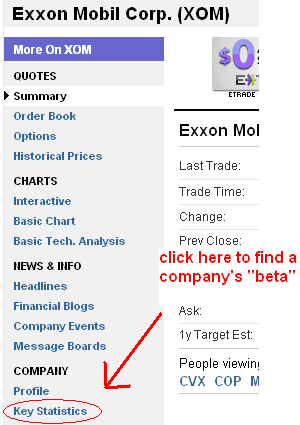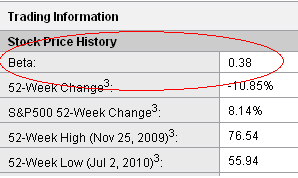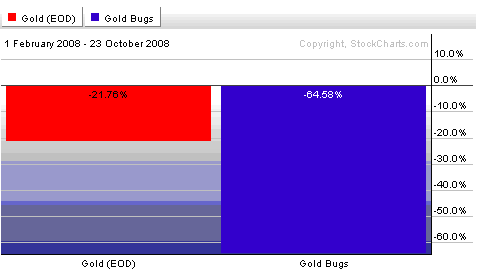- How risky are your stocks?
-
An investments that’s less volatile than the broad
market -
How to make volatility work for your
portfolio
Volatility is good for investors who have patience and a
concrete plan to take advantage of it.
At the risk of
pointing out the obvious, volatility simply refers to a security’s standard
deviation of returns – in other words how much variation there is from the
average. It’s also helpful to consider a securities’ volatility relative to
the market, and we have a handy metric for this called “beta.”
On Yahoo!
Finance, for instance, you can find a company’s beta by clicking on the
“key statistics” tab along the left side of the screen. I’ve cut and paste
some screen-grabs from ExxonMobil (NYSE: XOM) to show you
how to find beta.
I’m using Exxon as an example – but you can find almost any
company’s beta using the same process. (Some companies on foreign exchanges
as well as ETFs won’t have a beta listed – depending on the stock portal
you’re using.)

You’ll note that in my example, Exxon has a beta of
0.38.
Companies with a beta of 1 tend to have the same degree of
volatility as the broad market. A company with a beta greater than one will
be more volatile than the market, and a company with a beta less than one
will be less volatile than the market. If you see a security with a negative
beta, that means it tends to move in the opposite direction as the market, or
is negatively correlated.
Exxon – with its
beta of just 0.38 tends to be less volatile than the broad market. So if the
market moves up 10%, Exxon is likely to post less significant gains. Or if
the whole drops 10%, Exxon’s shareholders will likely see shares fall
less.
Of course, volatility is measured over a period of time so
don’t assume to see the above relationship on any given day. 
Rather my point is that you can use beta as a quick and
simple reference point to see how volatile a potential investment can be, and
then use market volatility to help you pick the best buy and sell points for
that security.
Which brings me to one of the most volatile groups of stocks
in the entire market:
Small cap gold and silver miners.
I won’t go into a long list of these companies with higher
betas than the broad market, but suffice to say that typically the only group
with higher volatility is the small-cap biotech sector.
If you have the background to understand and effectively
invest in biotech, the gains can be huge – but I certainly don’t have the
expertise or the patience to look at early-stage drug manufacturers or
specialized medical device companies.
For me, it’s much easier to understand a small cap precious
metal miner. They either have accessible reserves in a certain quantity or
they don’t. They either have the right personnel with a history of finding
and bringing gold to market, or they don’t.
But there’s a high degree of volatility in these stocks
because even with the best and brightest personnel and the most promising
reserves, the failure rate is high.
There’s also a further degree of uncertainty, because these
firms have to start their projects years ahead of time. Who knows what the
price of gold will be in five or ten years? More importantly, at what price
will gold and silver mines be profitable? Right now, a lot of precious metals
mining outfits are raking in the profits – but these margins could me
dramatically different in a couple of years, notwithstanding a 15% fall in
prices.
That’s not much of a safety cushion. Even though I’m
long-term bullish on gold and silver, a 15% correction is not out of the
question. And such a drop in the underlying metal price tends to be magnified
in the price of gold and silver mining stocks by our friend
“volatility.”
For instance, take a look at the hiccup in the price of gold
in 2008 plotted against the gold bugs index of the largest gold mining
companies:
Gold stocks fell three times further than the price of
gold.
The important thing
to remember is that volatility can be your friend. With small cap precious
metal miners, it’s not strange to see huge upswings and downswings in the
sector – so you can buy these companies at a substantial discount if you have
the patience and a plan.
Right now, you don’t need much patience. As I said last
week, I think we can afford to wait for Ben Bernanke’s announcement on
quantitative easing (QE). If his announcement disappoints to the downside, I
think we’ll see a substantial correction in gold and silver prices – and even
more substantial corrections for precious metals stocks.
I’d recommend putting in some lowball bids on your favorite
gold and silver companies ahead of Ben Bernanke’s announcement on November
2nd and 3rd.
I’d recommend putting in bids 10-40% below current prices.
If you have enough capital, you could put in bids at 10%, 20% and 40% and get
filled averaging in all the way.
If I’m wrong and Bernanke’s announcement doesn’t disappoint,
you won’t get filled.
If you’re interested in buying a basket of small cap gold
and silver stocks, my boss Ian Wyatt recently published a report on the
subject. You
can click here to read the full details.
Good investing,
Kevin McElroy
Editor
Resource Prospector
disclosure: I own Exxon, silver and gold
 Facebook
Facebook
 Twitter
Twitter
